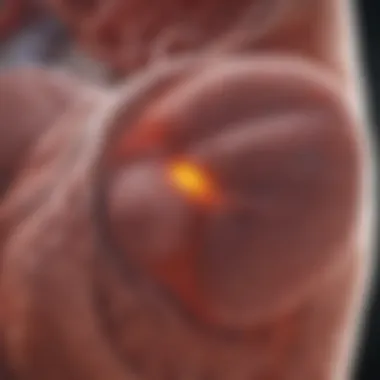Comprehensive Treatment Approaches for Liver Sclerosis


Intro
Sclerosis of the liver, often related to chronic liver diseases, poses significant challenges in both diagnosis and treatment. Understanding the precise nature of this condition is crucial for effective management. This overview will peel back the layers of complexity surrounding liver sclerosis, focusing on the treatment options available today. By addressing underlying causes, diagnostic techniques, and emerging therapies, a clear framework can be established for optimizing patient care.
Key Concepts
Definition of Primary Terms
Liver sclerosis often refers to liver fibrosis, which is a pathological condition characterized by excessive accumulation of extracellular matrix proteins, leading to the scarring of liver tissue. In extreme cases, this can progress to cirrhosis, where liver function deteriorates significantly. Key terms related to liver sclerosis include:
- Fibrosis: The formation of excess fibrous connective tissue in an organ.
- Cirrhosis: Severe scarring of the liver often caused by long-term liver disease.
- Hepatitis: Inflammation of the liver.
Related Concepts and Theories
The underlying causes of liver sclerosis stem from various factors such as viral infections, long-term alcohol abuse, and metabolic disorders. Each of these conditions contributes to the inflammatory processes that drive fibrosis. The well-known concept of the "liver injury cascade" explains how repeated injury leads to a progressive scarring process, making understanding these pathways critical in developing targeted therapies.
Treatment Modalities
Treatment approaches for liver sclerosis can be classified into several categories:
- Medical Therapies: These include antiviral medications for hepatitis, immunosuppressive drugs in autoimmune liver diseases, and medications aimed at controlling metabolic factors like diabetes or obesity.
- Lifestyle Adjustments: Encouraging dietary changes, physical activity, and cessation of alcohol intake can significantly affect liver health.
- Surgical Interventions: In severe cases, liver transplantation remains a definitive treatment.
These treatment strategies not only target the fibrosis itself but also the underlying causes to prevent further damage.
"Understanding the cause of liver sclerosis is as important as the treatment itself."
Future Directions
Gaps Identified in Current Research
While significant progress has been made in treating liver sclerosis, gaps still exist in our understanding of the exact mechanisms that drive fibrosis. Research is needed to explore:
- The genetic predispositions to liver fibrosis.
- The long-term efficacy and safety of new antifibrotic agents.
Suggestions for Further Studies
Future studies should aim to:
- Investigate novel biomarker discovery for early diagnosis.
- Explore the role of gut-liver axis in managing liver diseases more effectively.
By filling these gaps, the scientific community can foster better treatment protocols and improve patient outcomes.
Understanding Sclerosis of the Liver
Sclerosis of the liver is a critical medical condition that impacts individuals worldwide. Understanding this topic is essential for delineating its ramifications on health, treatment pathways, and quality of life. By grasping the fundamental aspects of liver sclerosis, one gains valuable insights into various approaches that can aid patient outcomes.
Sclerosis represents an abnormal hardening of the liver tissue, often reflecting an underlying condition that affects liver function. Recognizing the early signs and symptoms of this disease can profoundly influence a patient's prognosis. As we navigate through this article, we will explore various dimensions related to liver sclerosis, including its definitions, types, causes, and the significance of early diagnosis. This knowledge is crucial not only for patients but also for medical professionals, caregivers, and researchers in crafting effective treatment strategies.
Definition and Overview
Liver sclerosis, also known as liver fibrosis, entails the formation of scar tissue in the liver, a response that occurs due to chronic liver injury. As the disease progresses, replacing healthy tissue with scarred tissue can lead to severe complications, including liver failure and other critical health issues. Understanding this definition is vital for anyone exploring treatment options and the implications of chronic liver conditions.
Types of Liver Sclerosis
Liver sclerosis is composed of various types, each arising from different underlying causes. Identifying the type is crucial since it influences management strategies and treatment decisions. Common types include:
- Alcoholic liver disease
- Non-alcoholic fatty liver disease
- Chronic viral hepatitis
- Autoimmune liver disease
By knowing the type, healthcare professionals can tailor appropriate treatment options to halt disease progression and improve the patient's well-being.
Etiology of Liver Sclerosis
The etiology, or cause, of liver sclerosis varies significantly based on individual health factors and historical circumstances. Here we will explore several prominent causes:
Alcoholic liver disease
Alcoholic liver disease occurs due to excessive alcohol consumption, leading to liver inflammation and damage. This condition is notable for its clear association with lifestyle and behavioral choices. Since many individuals with this type may ignore early signs, it often progresses unnoticed. It is a significant cause of liver-related illnesses worldwide and provides a clear target for preventative education and treatment plans.
Non-alcoholic fatty liver disease
Non-alcoholic fatty liver disease reflects the accumulation of fat in liver cells not attributable to alcohol. Its increasing prevalence parallels the obesity epidemic, making it a critical area of concern. It is essential for discussing lifestyle modifications, including diet and exercise, as part of treatment. This condition signifies growing metabolic issues within our populations, emphasizing the need for widespread awareness.
Chronic viral hepatitis
Chronic viral hepatitis arises from persistent infections like Hepatitis B and C, which can cause long-lasting liver inflammation and damage. It represents a crucial factor in global health, leading to significant liver morbidity and mortality. Understanding its role in sparking sclerosis is fundamental, particularly regarding how antiviral treatments can mitigate progression and liver damage.


Autoimmune liver disease
In autoimmune liver disease, the body's immune system mistakenly attacks liver cells, leading to inflammation and scarring. This condition highlights the complex interplay between genetics and environmental triggers. For patients and healthcare providers alike, recognizing autoimmune liver disease is essential. Early detection and tailored immunosuppressive therapy can yield favorable outcomes in managing this serious health issue.
Understanding the etiology of liver sclerosis enables healthcare providers and patients to devise informed treatment plans and lifestyle changes that can improve health outcomes.
Pathophysiology of Liver Sclerosis
Understanding the pathophysiology of liver sclerosis is essential for developing effective treatments and management strategies. The mechanisms by which the liver becomes fibrotic can inform targeted therapeutic interventions. This knowledge enables healthcare professionals to understand not only the progression of the disease but also the potential for reversing liver damage in certain cases. In addition, understanding the staging of liver damage helps in determining the urgency and type of treatment needed.
Mechanisms of Fibrosis
Fibrosis in the liver is primarily a response to chronic injury. When the liver experiences persistent damage, the body attempts to heal itself through a process of repair. This involves activation of hepatic stellate cells, which play a key role in producing collagen and other extracellular matrix components. Over time, excessive accumulation of these materials leads to scar tissue formation, disrupting normal liver architecture and function.
Several factors contribute to this process:
- Chronic Inflammation: Conditions such as chronic viral hepatitis or autoimmune diseases lead to ongoing inflammation, promoting fibrosis.
- Oxidative Stress: Increased oxidative stress can damage hepatocytes, further encouraging the fibrotic response.
- Apoptosis: Cell death in liver cells stimulates repair mechanisms, but when excessive, it can accelerate fibrosis.
These mechanisms highlight the importance of early intervention. Targeting inflammation and oxidative stress may slow or even reverse fibrosis progression in some patients.
Staging of Liver Damage
Staging liver damage is crucial for patient prognosis and treatment decision-making. The staging system provides a framework to classify the severity of liver fibrosis. The common systems used include the METAVIR score and the Fibrosis-4 index, among others.
Each stage indicates the level of scarring, ranging from F0 (no fibrosis) to F4 (cirrhosis). Accurate staging can help determine:
- Treatment Options: Patients with early-stage fibrosis may benefit from lifestyle changes and medication, whereas those with advanced fibrosis may require monitoring for liver transplantation.
- Monitoring Frequency: The stage of liver damage can dictate how often a patient needs follow-up assessments.
- Risk Assessment: Understanding the stage may indicate a patient's risk of developing liver cancer or other complications.
Regular assessments provide valuable information for monitoring disease progression, improving patient outcomes.
Consequences of Advanced Sclerosis
As liver sclerosis progresses, it can lead to serious complications that affect overall health. Advanced liver sclerosis, or cirrhosis, presents several consequences:
- Liver Failure: The liver's ability to perform its vital functions diminishes, leading to life-threatening conditions.
- Portal Hypertension: Increased blood pressure in the portal vein can cause sepsis, varices, and spontaneous bacterial peritonitis.
- Hepatocellular Carcinoma: Patients with advanced sclerosis have an elevated risk of liver cancer.
Advanced liver sclerosis is not merely a diagnostic label; it signifies a critical point in disease progression that demands aggressive management strategies to prevent irreversible damage.
In summary, understanding pathophysiology provides a blueprint for clinicians and researchers alike. By grasping the underlying mechanisms and staging liver damage, the management of liver sclerosis can be approached more effectively. This understanding encourages innovative ideas for ongoing research into more effective treatment options.
Diagnosis of Liver Sclerosis
Diagnosis of liver sclerosis is a critical step in the management of liver diseases. Accurately identifying the condition allows for timely intervention, which can mitigate further damage and improve patient outcomes. Understanding the diagnostic process not only aids in effective treatment decisions but also provides a foundation for developing long-term management plans. This section will explore various diagnostic methods, emphasizing their importance and relevance to the overall understanding of liver sclerosis.
Clinical Evaluation
Clinical evaluation encompasses a thorough assessment of a patient's medical history and symptoms. Doctors consider several factors, including the patient’s history of liver-related ailments, substance use, and other risk factors that may contribute to liver pathology. Symptoms such as jaundice, fatigue, and abdominal discomfort often prompt further investigation. The clinical evaluation is vital as it guides the healthcare provider towards selecting appropriate diagnostic strategies and making informed treatment decisions.
Diagnostic Imaging Techniques
Ultrasound
Ultrasound is commonly used in the diagnosis of liver sclerosis due to its accessibility and non-invasive nature. This imaging technique allows for real-time visualization of the liver structure, helping to identify any abnormalities. One of the key advantages of ultrasound is that it can detect changes in liver size and texture, which are essential indicators of liver disease. Moreover, ultrasound does not expose patients to harmful radiation, making it a safe choice, especially for routine screenings. However, its limitations include operator dependency and reduced effectiveness in obese patients.
CT scan
The CT scan provides a more detailed view of the liver and surrounding structures compared to ultrasound. It is especially useful in evaluating the extent of scarring and identifying other potential liver complications. A key characteristic of CT scans is their ability to produce cross-sectional images, which offer a comprehensive look at internal organs. This allows healthcare professionals to assess the liver's condition more accurately. On the downside, CT scans involve exposure to ionizing radiation, which raises concerns related to safety. Therefore, the risks versus benefits must be evaluated before proceeding with this imaging modality.
MRI
MRI stands as a powerful diagnostic tool, known for its high-resolution images and ability to differentiate between tissue types. In the context of liver sclerosis, MRI can provide valuable information regarding liver architecture and fibrosis. A significant advantage of MRI is that it does not use radiation, making it safer for repeated assessments. Furthermore, specific MRI techniques, such as elastography, can measure liver stiffness, which is an indirect marker of fibrosis. However, MRI can be less accessible and typically comes at a higher cost than other imaging options.
Laboratory Tests
Laboratory tests play a significant role in confirming the diagnosis of liver sclerosis, as they evaluate the liver's functional capacity and detect markers of liver injury.
Liver function tests
Liver function tests are a group of blood tests used to assess the health of the liver. They measure the levels of various enzymes, proteins, and substances produced by the liver. These tests are crucial in detecting liver damage and monitoring the progression of liver disease. A unique feature of liver function tests is their ability to provide a snapshot of liver activity, helping physicians make real-time assessments. However, these tests can sometimes yield inconclusive results, necessitating further investigations to confirm the diagnosis.
Serological markers
Serological markers are specific blood tests identifying antibodies or antigens associated with liver diseases. These markers help in understanding the underlying causes of liver sclerosis, such as viral hepatitis or autoimmune conditions. The key characteristic of serological markers is their ability to guide targeted therapies by revealing the exact cause of liver damage. While serological testing is beneficial, the interpretation of results can sometimes be complex and may require additional context from clinical evaluations or imaging studies.
Medical Treatments for Liver Sclerosis


Medical treatments play a critical role in the management of liver sclerosis. Understanding the proper interventions is essential for effective patient care. These treatments target the underlying causes of liver damage, aims to halt or reduce further injury, and strives to enhance liver function. A well-considered treatment plan can greatly improve the quality of life for individuals experiencing liver sclerosis.
Pharmacological Interventions
Pharmacological interventions are often the first line of treatment for liver sclerosis. These medications aim to mitigate the progression of fibrosis and manage associated symptoms. Several classes of drugs are utilized, including antivirals for viral hepatitis and corticosteroids for autoimmune conditions. When treating a patient, it is crucial to tailor medication choices to the individual's unique situation, considering factors such as the severity of the disease and potential side effects.
Benefits of pharmacological interventions include:
- Slowing disease progression
- Improving liver function tests
- Reducing inflammation and fibrosis
Additionally, ongoing research aims to identify new pharmacological options. This is essential since the current treatments may not be effective for all patients. As such, continuous monitoring and adjustments in medication regimens are necessary to achieve optimal outcomes.
Liver Transplantation
For individuals with advanced liver sclerosis and liver failure, transplantation often represents the best chance for recovery. Liver transplantation involves replacing the diseased liver with a healthy one from a donor. This procedure addresses the root cause of liver dysfunction, providing a long-term solution to a life-threatening condition.
Considerations for liver transplantation include:
- Eligibility criteria, as not all patients qualify for the procedure
- The waiting list for donors, which can be lengthy
- The need for lifelong immunosuppressive therapy to prevent organ rejection
While transplantation can be a solution for severe cases, it is not without risks. Patients must have thorough evaluations and follow-up care, which is key to the success of this treatment.
Innovative Therapies
Innovative therapies are emerging to provide new options for patients with liver sclerosis. These treatments are still under investigation but show promise in addressing the complexities of liver disease.
Antifibrotic agents
Antifibrotic agents represent a key area of innovation. Their primary role is in reducing fibrosis by targeting specific molecular pathways responsible for scar tissue formation. By inhibiting the processes that lead to fibrosis, these agents aim to slow the progression of liver sclerosis.
A key characteristic of antifibrotic agents is their ability to specifically reduce collagen production, which is integral in the formation of scar tissue. Some of these agents are already in clinical trials, highlighting their potential as beneficial treatments. However, as with any new therapy, there are considerations regarding their long-term safety and efficacy.
Unique features:
- Specific targeting of fibrogenic pathways
- Reduction in liver stiffness as observed in clinical trials
The advantages of antifibrotic agents lie in their targeted approach, potentially leading to less systemic impact compared to traditional therapies. Nonetheless, their availability and approval are still limitations to consider for patients.
Immunomodulatory treatments
Immunomodulatory treatments focus on altering the immune response to prevent further liver damage. These treatments are particularly relevant in cases of autoimmune liver disease or chronic inflammation.
An important key characteristic of immunomodulatory treatments is their ability to re-balance immune systems, reducing excessive immune responses that contribute to liver injury. They have gained traction as a beneficial choice in specific patient populations.
Unique features:
- Targeting immune pathways to reduce inflammation
- Used in conditions like autoimmune hepatitis
The advantages of immunomodulatory treatments include reduced need for more aggressive therapy. However, the potential for side effects remains a critical consideration when implementing these therapies.
Effective management of liver sclerosis requires comprehensive attention to medical treatments, lifestyle modifications, and ongoing research into newer therapies. This holistic approach can enhance the well-being of affected individuals.
Lifestyle Modifications in Treatment
When managing sclerosis of the liver, lifestyle modifications play a crucial role. These changes are essential not just for improving liver health, but also for enhancing the overall quality of life for afflicted individuals. By implementing specific lifestyle adjustments, patients can effectively support their medical treatments and potentially slow down the progression of liver disease. The benefits of such modifications often include weight management, improved energy levels, and decreased risk of further complications.
Dietary Changes
Dietary changes are a fundamental aspect of lifestyle modifications in the treatment of liver sclerosis. Proper nutrition can significantly impact liver health and overall well-being.
Nutritional support
Nutritional support focuses on providing the body with the necessary vitamins, minerals, and nutrients essential for liver health. A diet rich in fruits, vegetables, lean proteins, and healthy fats can promote liver recovery and function. The key characteristic of nutritional support is its emphasis on balanced diets that are free from processed foods and excessive sugar.
Many healthcare professionals recommend this approach, as it can help reduce inflammation in the liver while providing essential nutrients. However, one unique feature of nutritional support is its ability to be customized according to individual needs, which is particularly advantageous for patients with varying levels of liver function. Nevertheless, it can require close monitoring from a nutritionist, making it less accessible for some.
Calorie restriction
Calorie restriction is another dietary modification that can aid in managing liver sclerosis. The premise behind calorie restriction is to reduce overall caloric intake, which in turn can lead to weight loss and improvement in liver function. This approach often helps patients who suffer from non-alcoholic fatty liver disease, a common type that can lead to further liver complications.
One distinguishing characteristic of calorie restriction is its potential to enhance insulin sensitivity, which is especially beneficial for those dealing with metabolic issues. On the downside, following a strict calorie-restricted diet may not suit everyone and could lead to nutrient deficiencies if not executed properly. Care must be exercised to ensure that while calories are reduced, nutritional needs are still fully met.
Regular Physical Activity
Regular physical activity is another critical lifestyle modification for patients with liver sclerosis. Engaging in consistent exercise helps to maintain a healthy weight, improve circulation, and enhance overall liver function. For many, beginning with low-impact activities, such as walking, can be beneficial. Over time, this can be increased to moderate exercises based on individual capability. Strength training can also be included, as it helps build muscle and reduces overall body fat, which is vital in managing liver conditions.


Alcohol and Substance Avoidance
Avoiding alcohol and harmful substances is paramount for individuals suffering from liver sclerosis. Alcohol consumption can exacerbate liver damage and significantly hinder recovery. Post-diagnosis, abstaining from alcohol is often recommended as a non-negotiable aspect of treatment. Additionally, avoiding recreational drugs and unprescribed medications further protects the liver from additional strain. Patients should discuss with their healthcare providers the importance of this abstinence and develop strategies to manage cravings or social situations where substance use is prevalent.
"Lifestyle changes can make a significant difference in the management of liver sclerosis. Small but consistent adjustments can offer tangible benefits for health outcomes."
Monitoring and Follow-Up Care
Monitoring and follow-up care are crucial components in the management of sclerosis of the liver. The disease can progress silently, leading to significant complications such as cirrhosis or liver failure if not managed properly. Regular monitoring helps in detecting deterioration early, thus allowing for timely intervention. Furthermore, it ensures that the chosen treatment approaches, whether medical or lifestyle-based, are effective and adjusted as necessary over time.
Importance of Regular Check-ups
Regular check-ups play a significant role in the management of liver sclerosis. These appointments provide an opportunity for healthcare providers to assess the patient’s condition thoroughly. Vital aspects to focus on during each visit include:
- Monitoring symptomatology: Patients often experience various symptoms as the disease progresses. Observing these changes can provide insight into how well the treatment is working.
- Reviewing laboratory results: Blood tests can reveal liver function levels, and any abnormalities can guide treatment adjustments.
- Emphasizing adherence to lifestyle modifications: Regular check-ups allow clinicians to support patients in maintaining essential lifestyle changes, such as dietary adjustments and substance avoidance.
- Emotional and psychological support: Dealing with any chronic condition can be challenging. Regular contact with healthcare providers can offer reassurance, counseling, and additional resources.
As a whole, these check-ups form a critical feedback loop that fine-tunes treatment strategies based on individual patient progress.
Assessment of Liver Function
Assessing liver function is an essential element of follow-up care for patients with liver sclerosis. Liver function tests (LFTs) are the cornerstone of this assessment. These tests measure various enzymes and proteins to ascertain how well the liver is functioning. Key considerations for liver function assessment include:
- Evaluating liver enzymes: High levels of enzymes such as alanine aminotransferase (ALT) and aspartate aminotransferase (AST) indicate liver damage.
- Monitoring bilirubin levels: Elevated bilirubin can signal problems with liver function, as it is processed in the liver.
- Checking for protein levels: Low albumin levels may indicate chronic liver disease impacting the liver's capacity to synthesize proteins.
- Prothrombin time: This measures how quickly blood clots, as a prolonged time can indicate impaired liver function.
In clinical practice, these evaluations guide the healthcare providers in tracking disease progression and determining the efficacy of treatments. By regularly monitoring all these factors, medical professionals can optimize care and work toward mitigating further liver damage.
In summary, effective monitoring and follow-up care are indispensable in managing sclerosis of the liver, offering patients the best possible chances of improving their health outcomes.
Regular assessments not only catch problems early but also adapt treatment plans to ongoing patient needs.
Research and Future Directions
Research in the field of liver sclerosis is critical for enhancing our understanding of the disease and developing effective treatment strategies. Ongoing studies aim to elucidate the fundamental mechanisms that drive the progression of liver fibrosis and identify potential therapeutic targets. This evolving research landscape may lead to novel interventions that can halt or even reverse liver damage, improving patient outcomes significantly.
Ongoing Clinical Trials
Clinical trials serve as a cornerstone for advancing treatment options. These trials test new therapies and assess their efficacy and safety. Currently, numerous clinical trials are underway, focusing on various aspects of liver sclerosis treatment. Some key areas of exploration include:
- New pharmacological interventions that target the fibrotic process directly.
- Immunotherapies designed to modulate the immune response in liver diseases.
- Combined treatment approaches, incorporating lifestyle modifications along with medical therapies.
Participation in these clinical trials can provide patients with access to cutting-edge treatments not yet available through conventional channels. Additionally, results from these studies contribute to the broader understanding of liver health, informing future clinical practice.
Advancements in Genetic Research
Genetic research is uncovering the complex biological pathways involved in liver sclerosis. By identifying specific genetic markers associated with the disease, researchers hope to develop personalized treatment plans tailored to the individual’s genetic profile. Some promising aspects of this research include:
- Genetic predisposition assessment that can help determine a patient's risk for developing severe fibrosis.
- Gene therapy approaches aimed at correcting or modifying the underlying genetic factors contributing to liver damage.
- Bioinformatics tools that analyze genetic data to predict disease progression and response to treatment.
These advancements could lead to more precise interventions, ultimately enhancing the success rates of treatments for liver sclerosis.
Emerging Technologies in Treatment
The landscape of treatment for liver sclerosis is rapidly evolving with the advent of new technologies. Innovative approaches are reshaping how care is delivered and how treatments are developed. Key technologies include:
- Nanotechnology, which allows targeted delivery of drugs to fibrotic tissues, minimizing side effects and maximizing therapeutic effects.
- Artificial intelligence and machine learning, which enhance diagnostic accuracy and help predict treatment outcomes based on large datasets.
- Regenerative medicine, leveraging stem cells to repair damaged liver tissues.
Each of these technologies brings unique potential, and their integration into standard practice may revolutionize the management of liver sclerosis.
Research and future directions in liver sclerosis treatment not only pave the way for innovative therapies but also improve the quality of care and patient lives.
The End
The conclusion of this article serves as a critical synthesizing point. It encapsulates the various treatment options available for sclerosis of the liver while reaffirming the significance of a comprehensive approach. Understanding the multifaceted nature of this condition is essential for both patients and healthcare providers. Here, it is pertinent to emphasize that managing liver sclerosis is not solely about medical interventions; it also encompasses lifestyle adjustments, continuous monitoring, and patient education.
The benefits of exploring all available treatment options deeply impact patient health outcomes. Establishing a diverse strategy allows for individualized care, which is paramount when dealing with a complex disease like liver sclerosis. It is crucial to convey that there is no one-size-fits-all solution; each patient presents a unique case requiring tailored strategies.
Moreover, knowledge of emerging technologies and ongoing research can open doors to innovative treatments that may not have been possible previously. Regular follow-ups and patient engagement in their health can lead to more effective management of the condition. Ultimately, a varied strategy enhances the potential for positive outcomes, making the conclusion an essential element that encourages reflection and plan of action for all involved in the treatment process.
Summary of Treatment Options
The treatment options for sclerosis of the liver span several domains ranging from medical to lifestyle changes. Here are key treatment modalities to consider:
- Pharmacological interventions: Several drugs target the underlying mechanisms of liver fibrosis and aim to halt its progression. Antifibrotic agents have shown some promise, but their long-term efficacy remains under investigation.
- Liver transplantation: In cases of severe liver damage, transplantation may be the only viable option. This procedure can offer a new lease on life for patients with end-stage liver disease.
- Innovative therapies: Emerging treatments, such as immunomodulatory therapies, represent exciting developments in care. These approaches harness the body’s own immune system to combat fibrosis, potentially reshaping treatment paradigms.
- Lifestyle modifications: Dietary changes and regular physical activity play an instrumental role in managing liver health. Especially, avoiding alcohol and substances that exacerbate liver conditions is crucial.
Each treatment option carries its own risks and benefits, requiring careful consideration and consultation with healthcare professionals.
Emphasis on Patient-Centered Care
Patient-centered care is a cornerstone of effective treatment for liver sclerosis. This approach prioritizes the patient's needs, preferences, and values, ensuring that they are at the forefront of all healthcare decisions. Here are some key elements:
- Informed decision-making: Patients should be educated about their condition and the available treatment options. This information empowers them to make informed choices regarding their care.
- Tailored care plans: Recognizing that each patient’s situation is unique, healthcare providers should develop customized treatment plans that reflect individual circumstances, including lifestyle, comorbidities, and personal preferences.
- Continuous engagement: Ongoing communication between patients and healthcare providers fosters a collaborative relationship. Regular check-ins and discussions about treatment effectiveness can guide adjustments in care as necessary.
- Support systems: Encouraging patients to involve family and friends in their care encourages adherence to treatment and provides emotional support.



